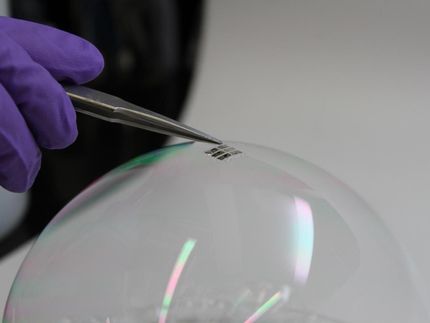Realizing carbon nanotube integrated circuits
Individual transistors made from carbon nanotubes are faster and more energy efficient than those made from other materials. Going from a single transistor to an integrated circuit full of transistors, however, is a giant leap.
"A single microprocessor has a billion transistors in it," said Northwestern Engineering's Mark Hersam. "All billion of them work. And not only do they work, but they work reliably for years or even decades."
When trying to make the leap from an individual, nanotube-based transistor to wafer-scale integrated circuits, many research teams, including Hersam's, have met challenges. For one, the process is incredibly expensive, often requiring billion-dollar cleanrooms to keep the delicate nano-sized components safe from the potentially damaging effects of air, water, and dust. Researchers have also struggled to create a carbon nanotube-based integrated circuit in which the transistors are spatially uniform across the material, which is needed for the overall system to work.
Now Hersam and his team at Northwestern University have found a key to solving all these issues. The secret lies in newly developed encapsulation layers that protect carbon nanotubes from environmental degradation.
"One of the realities of a nanomaterial, such as a carbon nanotube, is that essentially all of its atoms on the surface," said Hersam, the Walter P. Murphy Professor of Materials Science and Engineering. "So anything that touches the surface of these materials can influence their properties. If we made a series of transistors and left them out in the air, water and oxygen would stick to the surface of the nanotubes, degrading them over time. We thought that adding a protective encapsulation layer could arrest this degradation process to achieve substantially longer lifetimes."
Hersam compares his solution to one currently used for organic light-emitting diodes (LEDs), which experienced similar problems after they were first realized. Many people assumed that organic LEDs would have no future because they degraded in air. After researchers developed an encapsulation layer for the material, organic LEDs are now used in many commercial applications, including displays for smartphones, car radios, televisions, and digital cameras. Made from polymers and inorganic oxides, Hersam's encapsulation layer is based on the same idea but tailored for carbon nanotubes.
To demonstrate proof of concept, Hersam developed nanotube-based static random-access memory (SRAM) circuits. To create the encapsulated carbon nanotubes, the team first deposited the carbon nanotubes from a solution previously developed in Hersam's lab. Then they coated the tubes with their encapsulation layers.
Using the encapsulated carbon nanotubes, Hersam's team successfully designed and fabricated arrays of working SRAM circuits. Not only did the encapsulation layers protect the sensitive device from the environment, but they improved spatial uniformity among individual transistors across the wafer. While Hersam's integrated circuits demonstrated a long lifetime, transistors that were deposited from the same solution but not coated degraded within hours.
"After we've made the devices, we can leave them out in air with no further precautions," Hersam said. "We don't need to put them in a vacuum chamber or controlled environment. Other researchers have made similar devices but immediately had to put them in a vacuum chamber or inert environment to keep them stable. That's obviously not going to work in a real-world situation."
Original publication
Other news from the department science

Get the chemical industry in your inbox
By submitting this form you agree that LUMITOS AG will send you the newsletter(s) selected above by email. Your data will not be passed on to third parties. Your data will be stored and processed in accordance with our data protection regulations. LUMITOS may contact you by email for the purpose of advertising or market and opinion surveys. You can revoke your consent at any time without giving reasons to LUMITOS AG, Ernst-Augustin-Str. 2, 12489 Berlin, Germany or by e-mail at revoke@lumitos.com with effect for the future. In addition, each email contains a link to unsubscribe from the corresponding newsletter.




























































